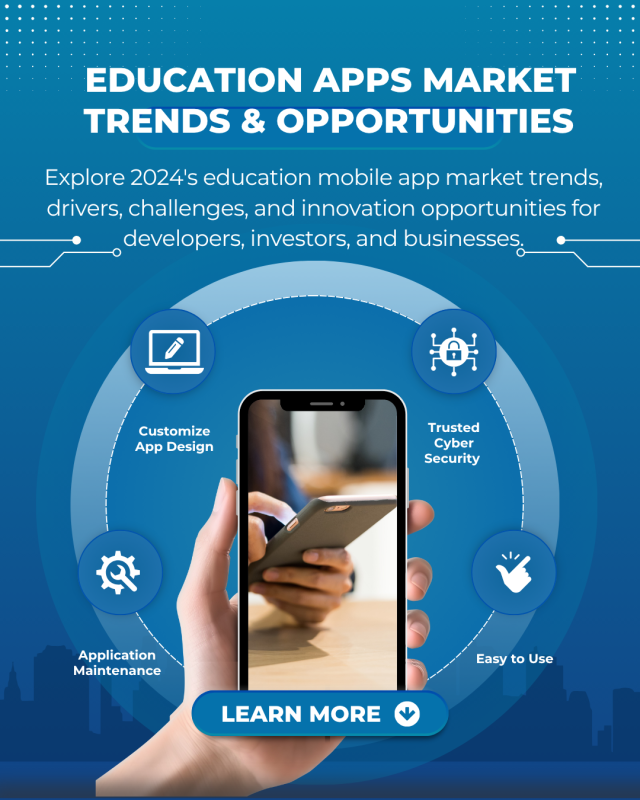Education mobile apps have revolutionized the way people learn, offering flexibility, accessibility, and interactive experiences. From gamified language learning platforms to subject-specific tutoring apps, this sector has grown exponentially over the past decade. But just how big is the education mobile apps market, and where is it headed? This blog explores the current state of the market, future trends, and opportunities available for both investors and developers.
Why the Education Mobile Apps Market Is Booming

The education sector’s digital transformation has propelled an explosion in demand for mobile apps. Key factors include increasing mobile device penetration, a growing global demand for accessible education, and the shift to online learning, accelerated by the pandemic.
Statistics back up this impressive growth:
Market Size: The global education apps market was valued at $8.4 billion in 2021 and is expected to grow at an annual rate of 27.49% from 2022 to 2030 (Grand View Research).
Downloads: Education app downloads jumped to over 470 million per week in mid-2020, compared to an average of 300 million in the previous two years (App Annie).
Popular Segments: Notable app categories driving this growth include language learning, test preparation, STEM-focused tools, and child-friendly interactive learning games.
Education mobile apps are no longer niche products; they’re mainstream tools backed by governments, educational institutions, and enterprises.
Key Market Drivers Shaping the Future of Education Apps
Increased Smartphone Penetration
The rise in smartphone adoption globally has made mobile technology the most accessible platform for learning. With more than 6.8 billion smartphone users worldwide (Statista, 2023), mobile apps have become effective tools not just in developed countries but also in emerging markets.
The Shift to Remote Learning
The COVID-19 pandemic forced educational institutions to quickly adapt to remote learning solutions. While in-person teaching has returned for many, the preference for hybrid learning models remains high. Mobile apps fill the gap, offering seamless access to learning materials, live classes, and assessments, no matter the location.
Gamification and Personalization
Today’s learners demand interactive and personalized experiences. Apps like Duolingo and Byju’s owe much of their success to gamification elements, including rewards, leaderboards, and challenge-based progression. Personalization, powered by AI, tailors the curriculum to a learner’s pace and knowledge gaps, enhancing engagement.
Government and Institutional Investments
Governments around the world are pushing for digital inclusion in education. For instance:
India’s NEP 2020 places a strong emphasis on integrating digital tools into the education system.
The US Department of Education has launched initiatives like the EdTech Developer’s Guide to support innovation in educational technology.
The Rise of EdTech Startups
From Khan Academy to Quizlet, startups dominate this market, bringing fresh ideas and innovation. Many startups are receiving substantial venture capital funding to develop creative solutions addressing diverse learning needs.
Trends to Watch in the Education Mobile Apps Market
The education apps market is dynamic, adapting continuously to new technologies and user expectations. Here are the five biggest trends expected to shape the future:
Artificial Intelligence in Education Apps
AI is transforming education apps through features like:
Adaptive learning algorithms that personalize lessons.
Automated grading and performance tracking.
AI-powered chatbots for instant support.
For example, platforms like Scribe Sense use machine learning to simplify grading processes, saving teachers significant time.
Expansion into AR and VR Learning
Augmented Reality (AR) and Virtual Reality (VR) are enhancing immersive learning. Apps are leveraging these technologies to provide virtual lab experiments, historical walkthroughs, and simulated career training. Think apps like MEL Chemistry or Google Expeditions.
Lifelong Learning and Upskilling Apps
Professional learning and career-focused skill-building apps are rapidly growing. With the gig economy and remote work culture, apps like Coursera and Udemy offer courses tailored to adult learners seeking industry certifications or new skills.
Integration With Wearables
Some developers are creating apps designed to work with wearables, like smartwatches, for microlearning. Health apps that offer educational guides for mindfulness and mental fitness are already testing these integrations successfully.
Focus on Localized Content
Emerging markets in Africa, Latin America, and Southeast Asia are demanding localized education tools. Apps tailored in terms of language, culture, and curricula are expected to capture these regions. This trend makes localization critical for any mobile app developer.
Opportunities for Growth and Innovation
The education mobile apps market offers plenty of opportunities, particularly for businesses and developers willing to innovate. Here’s where new players can focus:
Niche Segments: Address underserved areas such as special education, soft skills development, or adult literacy programs.
Collaborations: Partner with schools and government education initiatives to increase uptake.
Freemium Models: Offer basic features for free and premium-tier options for added value.
Green Features: Develop apps with minimal data requirements to cater to regions with limited connectivity.
Success hinges on understanding consumer needs, leveraging robust technologies, and delivering seamless usability.
Challenges in the Education Apps Market
Despite its prospects, developers entering the education mobile apps market may face these challenges:
High app-store competition, with thousands of apps already present.
User retention is difficult in a sector with frequent subscription cancellations.
Rapidly advancing technologies make it hard to stay ahead.
Regulatory compliance, especially in markets like Europe with stricter user data laws.
But with thoughtful strategy and innovation, businesses can thrive.
How Organizations Can Enter the Education Apps Market
For businesses considering launching education apps, here’s how to get started:
Conduct Market Research to identify gaps in the market.
Prototype and Test before scaling to ensure a seamless user experience.
Invest in Marketing to stand out, leveraging social media and SEO-driven content strategies to reach educators and parents.
Partner with Experts, such as curriculum designers or subject matter experts, to lend credibility to your app content.
Why the Education Apps Market Matters

Education mobile apps provide tangible solutions to global challenges, offering both individuals and institutions opportunities to overcome barriers like affordability, accessibility, and uneven teacher-to-student ratios. For businesses, this market combines purpose-driven goals with profitability, making it a promising space for innovation.




